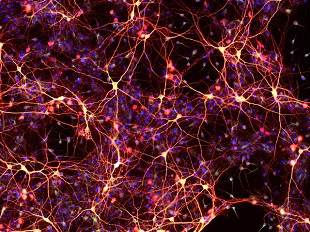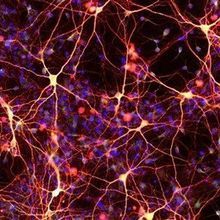 Neurons created from neural stem cells derived using a new direct cell reprogramming methodMINGLIANG ZHANG, PHD, GLADSTONE INSTITUTES (VIA EUREKALERT)Researchers have developed a method to directly reprogram cells using a combination of nine chemical compounds. The procedure bypasses the induced pluripotency step that has been used in previous chemical methods of cell reprogramming, as well as the gene introduction step that has been a focus of other attempts to reprogram cells directly. Led by stem cell biologist Sheng Ding at the Gladstone Institute of Cardiovascular Disease in San Francisco, the researchers demonstrated the procedure’s potential by reprogramming human skin cells into functional heart muscle and mouse skin cells into neural stem cells. The results were published last week (April 28) in Science and Cell Stem Cell, respectively.
Neurons created from neural stem cells derived using a new direct cell reprogramming methodMINGLIANG ZHANG, PHD, GLADSTONE INSTITUTES (VIA EUREKALERT)Researchers have developed a method to directly reprogram cells using a combination of nine chemical compounds. The procedure bypasses the induced pluripotency step that has been used in previous chemical methods of cell reprogramming, as well as the gene introduction step that has been a focus of other attempts to reprogram cells directly. Led by stem cell biologist Sheng Ding at the Gladstone Institute of Cardiovascular Disease in San Francisco, the researchers demonstrated the procedure’s potential by reprogramming human skin cells into functional heart muscle and mouse skin cells into neural stem cells. The results were published last week (April 28) in Science and Cell Stem Cell, respectively.
“This method brings us closer to being able to generate new cells at the site of injury in patients,”...
In the Science study, Ding’s team used trial and error to find a combination of chemicals that could induce human skin cells to turn into multipotent stem cells, and then into cardiomyocytes. Honing the technique, the researchers were able to produce a population of cells that molecularly resembled heart muscle and developed into apparently healthy heart muscle when transplanted in mouse hearts. “The ultimate goal in treating heart failure is a robust, reliable way for the heart to create new muscle cells,” study coauthor Deepak Srivastava of the Gladstone Institute of Cardiovascular Disease said in the statement. “Reprogramming a patient’s own cells could provide the safest and most efficient way to regenerate dying or diseased heart muscle.”
Separately, Ding and colleagues developed an equally direct, nine-chemical method for reprogramming mouse skin cells into neural stem cells that have the potential to form neurons. These results appeared in Cell Stem Cell. “In the future, we could even imagine treating patients with a drug cocktail that acts on the brain or spinal cord, rejuvenating cells in the brain in real time,” study coauthor Yadong Huang of the Gladstone Institute of Neurological Disease said in the statement.
Stem cell researcher Paul Knoepfler of the University of California, Davis, who was not involved in the work, noted on his blog that the studies did not delve into the frequencies of mutations or the potential for tumorigenesis in the chemically reprogrammed cells. “Whole-genome sequencing data will be needed,” he wrote. But he also observed that the findings are “a big step in the right direction” to make direct reprogramming a reality, calling the reports “a very big deal.”
Interested in reading more?





